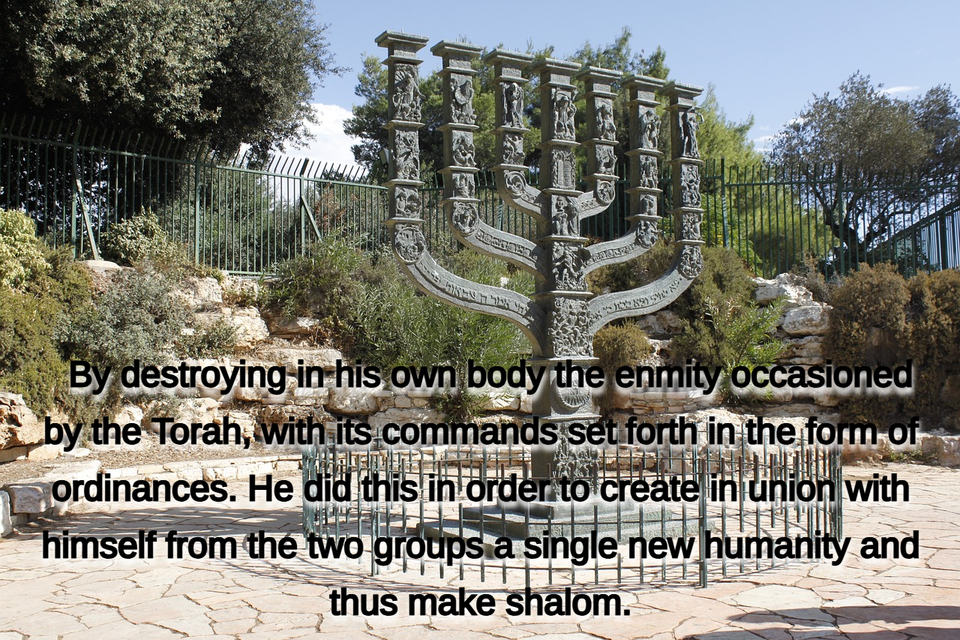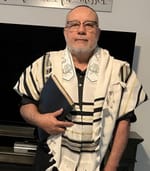“Abolishing the Enmity”

Ephesians 2:15 has long been used by traditional Christianity to argue that Y’hoshua HaMashiach abolished the Torah. However, a deeper reading within its Jewish context—and in light of Messianic Jewish scholarship—reveals that Sha’ul (Paul) is not declaring Torah invalid, but proclaiming that the enmity (ἔχθρα) that divided Jews and Gentiles has been nullified through the atoning flesh of Y’hoshua. The Torah remains holy and good; it is the hostility arising from its misuse and misunderstanding that has been abolished.
A Messianic Jewish Reading of Ephesians 2:15.
Ephesians 2:15 (Greek text):
τὴν ἔχθραν, ἐν τῇ σαρκὶ αὐτοῦ τὸν νόμον τῶν ἐντολῶν ἐν δόγμασι καταργήσας, ἵνα τοὺς δύο κτίσῃ ἐν αὐτῷ εἰς ἕνα καινὸν ἄνθρωπον, ποιῶν εἰρήνην.
CJB-style rendering:
“By abolishing in His flesh the enmity occasioned by the Torah, with its commands set forth in the form of ordinances, He did this to create in union with Himself from the two groups a single new humanity and thus make shalom.”
Context: Jew, Gentile, and the Wall of Division
Sha’ul’s argument in Ephesians 2:11–22 unfolds as follows:
- Gentiles were once alienated, “excluded from the commonwealth of Yisra’el and strangers to the covenants of promise” (vv.11–12).
- Through Y’hoshua’s blood, they are brought near (vv.13–14).
- Y’hoshua Himself is “our shalom,” breaking down the “middle wall of partition” (τὸ μεσότοιχον) that divided Jew and Gentile (v.14).
- Verse 15 explains how that wall was broken: by abolishing the enmity, the law of commandments in ordinances.
- The result is that the two—Jew and Gentile—are made “one new man” in Him, creating true peace (vv.15–16).
This passage culminates with the image of a united spiritual Temple in which both are built together as a dwelling for Elohim through the Ruach HaKodesh (vv.19–22).
The “dividing wall” (Greek: mesotoichon) likely alludes to the soreg—the actual stone partition in the Beit HaMikdash that separated Jews from Gentiles (as described by Josephus). This wall symbolized exclusion. By His death, Y’hoshua tore down the spiritual barrier that this wall represented.
Understanding the Greek Phrases
1. τὴν ἔχθραν (tēn echthran) — “the enmity / hostility”
Sha’ul’s focus is not that Torah itself was abolished, but that hostility was. The enmity was the relational and covenantal division between Jews and Gentiles—exacerbated by misunderstanding and misuse of the Torah’s commandments as ethnic boundary markers.
2. ἐν τῇ σαρκὶ αὐτοῦ (en tē sarki autou) — “in His flesh”
This refers to Y’hoshua’s physical sacrifice—His crucifixion—where He bore sin and removed the curse that divided humanity (Romans 8:3; Galatians 5:24). It was through His suffering and death that reconciliation was achieved.
3. τὸν νόμον τῶν ἐντολῶν ἐν δόγμασι (ton nomon tōn entolōn en dogmasi) — “the law of commandments in ordinances”
This phrase is central. The word dogmata (“ordinances”) refers to decrees or regulations. In context, it does not mean Torah itself, but the legal decrees and ritual regulations that functioned as social dividers. These often included purity laws and ceremonial boundaries that separated Jew and Gentile.
Messianic Jewish commentators understand dogmata as referring to the legal framework that created separation, not the moral or covenantal Torah. The Torah is holy; but the enmity caused by its misuse is what was abolished.
4. καταργήσας (katargēsas) — “having abolished / rendered powerless”
The verb katargeō means to make inactive, to nullify, or to render ineffective—not to destroy. Thus, Y’hoshua rendered ineffective the dividing ordinances that produced hostility between Jew and Gentile—He did not destroy the Torah itself.
Messianic Jewish Interpretations
David H. Stern (Jewish New Testament Commentary)
Stern translates Ephesians 2:15 as:
“By destroying in His own body the enmity occasioned by the Torah, with its commands set forth in the form of ordinances.”
Stern notes that it was the enmity occasioned by the Torah—not the Torah itself—that was destroyed. He emphasizes that Y’hoshua removed the social and ritual barriers, allowing Gentiles to be reconciled without nullifying Torah’s validity. Stern’s view affirms Torah observance for Jewish believers while explaining how the separation between Jew and Gentile has been healed in Mashiach.
D. Thomas Lancaster (First Fruits of Zion)
Lancaster’s broader teaching on Sha’ul’s letters highlights the Jewish context of Torah and covenant. He explains that Y’hoshua’s death disarmed the hostility created by the boundary-markers—those ceremonial distinctions that became barriers between Jew and Gentile. Y’hoshua did not abolish Torah; He restored its intended purpose: to bring life and reveal YHVH’s holiness.
Dr. David Rudolph (One New Man Theology)
Rudolph argues that Sha’ul’s “One New Man” is neither a “One New Jew” nor a “One New Gentile.” Rather, it is a reconciled community of both, united in Y’hoshua, where each retains their covenantal identity. He writes that the enmity was the hostility, not the distinctiveness, that separated Jews and Gentiles. Thus, Torah identity and covenant faithfulness remain intact, but enmity is abolished.
D.B. Woods (Jew-Gentile Distinction in the One New Man)
Woods affirms that Ephesians 2:15 does not erase all distinction. The “One New Man” preserves diversity within unity. The enmity abolished by Y’hoshua is not ethnic identity but relational hostility. Sha’ul’s vision is a unified but plural body—many members, one Spirit.
A Messianic Jewish Exposition
1. What Was the Enmity?
The echthra (hostility) was the alienation between Jews and Gentiles that resulted from covenantal and ritual separation. Human additions to the Torah and attitudes of superiority intensified this division.
2. How Did It Arise “by the Torah with Its Ordinances”?
The Torah itself is perfect (Tehillim [Psalms] 19:8), but its ceremonial and judicial regulations distinguished Yisra’el from the nations. Over time, these became barriers through rabbinic fence-laws or Gentile exclusion. Thus, the enmity was not Torah’s fault but humanity’s misuse of Torah.
3. What Did Y’hoshua Do?
Through His flesh—His death—Y’hoshua rendered inoperative the hostility born of misused ordinances. He removed every obstacle to covenant fellowship without negating Torah’s truth or holiness. As Sha’ul wrote elsewhere, “Do we then nullify the Torah through faith? May it never be! On the contrary, we uphold the Torah” (Romans 3:31).
4. What Is the Result?
Jew and Gentile now form one new man in Mashiach (Ephesians 2:15). This unity is not sameness; it is reconciliation. The Gentile is grafted into Yisra’el’s covenant blessings (Romans 11), while Jewish identity is preserved as the root and calling of the covenant people. Together, they form the spiritual Temple of YHVH (Ephesians 2:21–22).
Implications for our faith Netzari Mashiach Judaism
- Torah Remains Central – Y’hoshua did not abolish Torah; He abolished the hostility. The Torah’s moral and ethical imperatives remain valid for all talmidim, and its covenantal obligations remain binding for Yisra’el.
- Unity Without Uniformity – In the Body of Mashiach, unity does not erase identity. Jews remain Jews; Gentiles remain Gentiles—each walking faithfully in their calling while honoring one another in love.
- Reconciliation as Testimony – The unity of Jew and Gentile in Y’hoshua demonstrates the power of redemption and fulfills YHVH’s promise to bless all nations through Avraham’s seed (Berĕshith [Genesis] 12:3).
Conclusion
Ephesians 2:15 reveals not the abolition of Torah, but the redemption of relationship. The Torah remains holy, just, and good (Romans 7:12). What was abolished in Y’hoshua’s flesh was the hostility—the misuse of Torah by man, that fostered division. Through His atoning sacrifice, Y’hoshua reconciled Jew and Gentile into one redeemed community, united in purpose and bound by love under the eternal covenant of YHVH.
By Rabbi Francisco Arbas
📧 franciscoarbas.yisrael@gmail.com
Following His ‘WAY’ — Netzari Mashiach Judaism

Comments ()